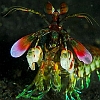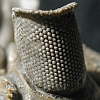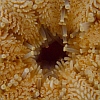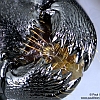What Would Technologically Advanced Aliens Be Like
 Recently, I came across various versions of the question that's the title of this post, such as this Popular Mechanics article, What Would Aliens Actually Look Like? We Asked 7 Experts, and multiple Quora questions (Would aliens look humanoid and if so, why?, What are the odds that if aliens exist, they would look like how they are portrayed in science fiction?, What might alien life look like?, Is it possible that aliens look like humans?, and What do aliens look like?). People's responses range from thoughtful to idiotic (even in the Popular Mechanics article among so called experts). But, it's an intriguing question, so I thought I'd give it a go at an answer.
Recently, I came across various versions of the question that's the title of this post, such as this Popular Mechanics article, What Would Aliens Actually Look Like? We Asked 7 Experts, and multiple Quora questions (Would aliens look humanoid and if so, why?, What are the odds that if aliens exist, they would look like how they are portrayed in science fiction?, What might alien life look like?, Is it possible that aliens look like humans?, and What do aliens look like?). People's responses range from thoughtful to idiotic (even in the Popular Mechanics article among so called experts). But, it's an intriguing question, so I thought I'd give it a go at an answer.
First of all, I'm focusing specifically on intelligent, technological alien life. Just a look at all the varied life forms that exist and have existed on this planet shows all the crazy paths life can take, from giant sequoias to mantis shrimp to sponges to pterodactyls to clams to flying fish to dolphins to snakes to bombardier beetles to mushrooms to ants to Venus fly traps to amoebas to orchids to cuttlefish... There are seemingly endless ways to go about the business of survival and reproduction. But the type of intelligence and body that can produce technology is something a bit more specific, and perhaps something where I can conjecture a bit more constructively.




To be clear, I'm not saying it's likely that we'll ever discover technologically advanced aliens. In fact, I think it's distinctly unlikely. Life existed on this planet as solely single-celled life for billions of years. And even after multicellular life appeared, it was nearly another billion years before us humans evolved with our technologically advanced civilization. And our civilization has only been around for mere thousands of years - note even a drop in the bucket compared to the total history of life on this planet. This entry is looking at the prerequisites to developing technologically advanced life.
One thing to keep in mind is that, just like on Earth, aliens, or at least their original natural form if they've entered into a realm of genetic engineering or artificial intelligence, are going to be the products of evolution, just like us. And we know from the way evolution works here, that it doesn't produce anything miraculous. Sure, there are very, very interesting forms that have evolved. But evolution is limited by contingency, and every feature of an organism is a tradeoff between advantages and disadvantages, not least of which is the nutrition needed to grow and maintain that feature. And everything everywhere is still governed by the same natural laws - physics, chemistry, etc. So we shouldn't expect aliens to have any 'superpowers' relative to what's seen on this planet - no magic levitation abilities, no telekinesis, no telepathy, no absurdly strong muscles, etc. And we shouldn't expect features that are nearly impossible to imagine evolving in a stepwise manner, like wheeled axles. Aliens will be organisms that evolved naturally to fit a niche.
With the caveats out of the way, let's start at the most basic level, first. Aliens will most likely use carbon based chemistry. Carbon simply offers the richest chemistry of any element in the periodic table. To quote Wikipedia, "The most important characteristics of carbon as a basis for the chemistry of life are, that it has four valence bonds, that the energy required to make or break a bond is at an appropriate level for building molecules, which are stable and reactive. Because carbon atoms bond readily to other carbon atoms allows for the building of arbitrarily long complex molecules and polymers." In fact, many of the building blocks of life, such amino acids, have been found naturally occurring in non-biological conditions, such as in comets. The fact that these basic building blocks will spontaneously form given the right conditions certainly suggests that they could be present in some primordial body of water and, given further appropriate conditions, give rise to life. About the only other element with a chance of being the basis for life is silicon, but its chemistry isn't as rich as carbon's, and nobody has yet found the type of naturally occurring large molecules and polymers with silicon as what occurs with carbon.
Alien life will more than likely have some type of long chain molecule (a polymer) similar to DNA. There can be lots of interesting chemistry without this type of molecule, but probably not to the same complexity, and not with the same basis for duplication with slight mutations that's the foundation of evolution. But that DNA like molecule need not necessarily be DNA. In an interview for the Guardian article, DNA alternative created by scientists, Phillip Holliger, who's studied alternatives to DNA, stated, "There is nothing Goldilocks about DNA and RNA. There is no overwhelming functional imperative for genetic systems or biology to be based on these two nucleic acids." Holliger has created and studied alternative polymers, collectively known as XNAs. Perhaps one of these would be the basis for alien life.
Moving past the basic level, I'm going to jump quite a bit ahead in the aliens' evolution. They'll almost surely be terrestrial. As I said before, keep in mind that we're focusing on technologically advanced, not just intelligent. You can certainly have intelligent animals evolve in any environment (e.g. dolphins). But it's hard to imagine how advanced technology could develop in an aquatic habitat. For one thing, so much of our technological development has hinged on fire, from cooking, to smelting metals, to combustion engines, etc. Without fire as an energy source, it's hard to see how many of those technologies could have been developed. Then there's materials science and chemistry. In a terrestrial environment, it's easy to isolate solids and liquids in different containers, allowing chemistry to get started. How do you isolate liquids when you're underwater.
The overall size of the aliens would probably be in the ballpark of us, but would depend an awful lot on the specifics of the planet they're from. As a first cut, we can probably say that they wouldn't be much smaller than us. Being smart takes a certain amount of raw brain power, and brain power that can be devoted to general intelligence, not just the normal 'housekeeping' chores of processing nerve impulses or controlling organs. There's no telling just how exactly an alien brain would work, but assuming that it's about as efficient as the brains that have evolved on this planet, it will be proportionately sized to the organism. For example, a spider will never be as smart as a person, because it's just too small to have a brain big enough to do the job. To have a brain big enough to have a high level of intelligence, the aliens will have to be reasonably sized. As far as an upper limit on size, that's probably going to be very specific to the planet and the organisms' physiology. On this planet, gravity and the square cube law place upper limits on how big terrestrial organisms can get. If aliens came from a planet with lower gravity, they could probably grow larger. But even on this planet, humans are nowhere near the upper limit for how big terrestrial animals can get. The largest land mammals ever probably weighed around 20 tons, while the largest dinosaurs were probably around 70 tons. Moreover, ancient elephants are contenders for largest land mammal, and they also happen to be among the smartest mammals. So, I think about the best range I can estimate is from a low end of several dozen pounds to a high end of several tons, or even larger if the planet has lower gravity.

It's hard to predict what type of skeleton aliens would have (not even getting into the chemistry of it, just the basic structure), but we can narrow it down somewhat. There are four types of structural support that animals on this planet use - endoskeletons (like us), exoskeletons (like insects), hydrostatic skeletons (like earthworms or starfish), and muscular hydrostats (like octopus and squid). Considering that we've already narrowed down our technological aliens to terrestrial organisms, I think we can rule out those latter two types of support. While they're sometimes used in certain structures of large terrestrial animals on this planet (like our tongues or an elephant's trunk), the only terrestrial animals we know of that use them for their entire structure are rather small. It seems that to support large bodies, some type of hard skeleton is required (assuming that gravity isn't drastically lower on their planet). But whether aliens would use endo- or exo- skeletons is tougher to answer. The largest known terrestrial animal from this planet to use an exoskeleton was Arthropleura, an 8 ft long millipede that weighed several hundred pounds (one site I saw said 1000 lbs). So, it doesn't appear that an exoskeleton is necessarily a limit to growing large. In fact, most of the articles I've seen describing why insects don't grow larger explain that it's mainly due to how they breathe. They rely on small tubes and diffusion, rather than lungs (e.g. Why can't insects grow much bigger?). If an organism had an exoskeleton AND lungs, it might just be able to grow to much larger sizes than current insects. So, I'm going to say that we can't narrow this down any further.
I've already discussed that the aliens would require a certain sized brain, but there's another aspect about brains worth considering - they take a lot of energy. Now, perhaps alien evolution would strike on a nervous system that was more efficient than ours, but I think chances are that naturally evolved biological computers will always take a lot of energy, especially if the organisms are using those brains full-time to think about things. And that type of energy means the organisms will probably be warm-blooded - chemical reactions and metabolism can be much more efficient when they're operating at a consistent warm temperature. And the vast, vast majority of warm blooded terrestrial animals on this planet have some type of insulation for a body covering - hair or fur in practically all mammals, feathers in birds and other dinosaurs, and pycnofibers in pterosaurs. Humans are one of the rare exceptions to this pattern. So, more likely than not, intelligent aliens will have something similar to fur or feathers covering their bodies for insulation.
Speaking of energy requirements, one of the reasons we can have such energetic metabolisms is oxygen. Oxygen is very reactive. That's very clear from watching a fire burn. The metabolism that takes place within our cells is a more controlled version of those types of reactions. So, in order to have the metabolisms to support those energy intensive brains, technological aliens will probably be living on a planet with lots of free oxygen in the atmosphere, which also goes back to what I mentioned before about the importance of fire for driving technological development. (And as an interesting aside, this also tells us something about the other life on that planet - go read about the Great Oxygenation Event to see how Earth got its oxygenated atmosphere.) And to get that oxygen distributed throughout their bodies, aliens are going to need some type of circulatory system (and some type of respiratory system, as well). And a circulatory system needs blood. But what type of blood? Here's an article discussing different types of blood in creatures on this planet, Crabs have blue blood; why don't we?. In short, iron and copper appear to be the best suited elements for transporting oxygen, and so intelligent aliens would probably have blood based on one of those elements. Though the article also mentions vanadium based blood, so I suppose there's a small chance their blood could use some other element.
Aliens will have various sensory organs. From physics, many will probably be similar in function to ours - touch, taste, and smell as very obvious senses, interacting directly with the matter in their environment. Hearing to detect sound is also pretty likely, seeing as how that has evolved in many lineages of animals on Earth (insects use a tympanal organ). Sight also seems very likely, considering how many animals on this planet have eyes. But what type of eyes would aliens have? Eyes have evolved numerous times on Earth, but almost all fall into two camps simply because of the constraints of physics - compound eyes and camera-type eyes. In fact, as complex as camera-type eyes may seem, even they have evolved multiple times, in both us and molluscs. And while camera-type eyes may offer potentially higher resolutions, both camera and compound eyes are effective means of forming an image. There is a third possibility that we know of from telescopes, and that I just learned is actually used in scallops - a reflector eye. But, out of all the eyes in the animal kingdom, reflector eyes seem to be pretty rare, so I think we can narrow down our aliens to either compound or camera-type eyes, but no further than that.




Aliens will need mouths of some sort. They're going to need to eat, and a mouth, by definition, is the orifice that gets food into the digestive tract. But from there, who knows what those mouths might look like. Chances are decent it will have some type of hinge to facilitate biting, but even that's not a given. Really, just take a look at a small sampling of the mouths from organisms on Earth.




These aliens are going to have some types of limbs or appendages, if only for the reason that they'll need something to manipulate their environment very finely to be able to develop and build their technology (again, because we're looking at prerequisites to technologically advanced aliens, not that there's any inherent reason why this type of feature would necessarily evolve on an alien planet). We have hands. Elephants have trunks, and it's very easy to imagine that if they had two trunks, they'd be building things. Squids have tentacles that they're very adept at using. And while it's conceivable these aliens could be slug-like with muscular tentacles, since we've previously determined that they're probably going to be warm-blooded, energy hungry organisms, they'll probably be more active and need to get around faster than what slugs can do. So, at least some of their limbs are probably going to be for locomotion. So, how many limbs will they have? For an interesting discussion of limb evolution on Earth, check out this article, A Tale of Three Arms. It discusses the independent evolution of limbs in vertebrates like us, arthropods (including insects), and molluscs. A lot of the reason life looks they way it does now is because of those evolutionary histories and contingencies. We have four limbs because our lobe-finned fish ancestors had four fins. If they'd had six fins, we'd likely have six limbs. And if they'd had segmented bodies like millipedes, we might have a hundred limbs. To set a minimum, I'd say terrestrial animals will almost always have at least four limbs. It's the minimum required to make walking easy for the first organisms to venture onto land. Above that, there's no telling. If their manipulatory limbs were modified from locomotion limbs like us, they could still have as few as four limbs. If they evolved from six- or eight- or ten-limbed ancestors, they'd probably retain that number. And if they had so many limbs, there's no reason to think they'd only be limited to two manipulatory limbs. Or, like I already hinted at above, their manipulatory limbs might have evolved from something other than locomotion limbs, similar to an elephant's trunk.
As far as behavior, they'll almost certainly be social. Developing technology depends on building on the knowledge from others that came before you. And you can't share that knowledge effectively without being social and interacting with others. And that sharing will require some type of language - not necessarily spoken with sound waves, but some way to transfer concrete and abstract ideas from one individual to another.
So to summarize, my best guess is that if any intelligent technologically advanced aliens have evolved, they will probably be carbon based, with some type of polymer genetic chemical, though not necessarily DNA, terrestrial, either similar in size to us or much larger, have some type of hard skeleton, either internal or external, warm-blooded with some type of fur or feather like insulation covering their bodies, oxygen-breathing with iron or copper based blood, with various sensory organs similar to ours and either compound or camera-type eyes with a slim possibility of reflector eyes, mouths that we can only narrow down to being some type of orifice to take in food though a hinge of some sort is possible, have at least four limbs if not more, and will be social with language. Now, take all that and try to imagine what it would look like coming together, and there's a near limitless number of possibilities.
Title Image Source: Wikimedia Commons
Updated 2017-11-07: Add paragraph about technologically advanced alien life being unlikely, along with related caveat in final paragraph.

Comments
lipitor oral oral atorvastatin 20mg buy atorvastatin 80mg for sale
Posted by: Wrywyk | March 12, 2024 12:35 PM
buy generic ciprofloxacin 1000mg - ethambutol for sale clavulanate cheap
Posted by: Xuzvkl | March 14, 2024 3:29 AM
ciprofloxacin pill - augmentin 1000mg tablet augmentin 1000mg usa
Posted by: Rcoiof | March 15, 2024 5:08 AM
buy cheap ciprofloxacin - order doxycycline pill erythromycin 500mg uk
Posted by: Cklyoh | March 17, 2024 7:56 AM
flagyl cost - cleocin sale order azithromycin 250mg online
Posted by: Zpftht | March 18, 2024 1:48 AM
stromectol 12mg online - buy sumycin generic sumycin price
Posted by: Mnrsow | March 19, 2024 11:48 AM
generic valtrex 1000mg - nateglinide over the counter order acyclovir generic
Posted by: Rwsqbk | March 20, 2024 6:55 AM
ampicillin online buy doxycycline uk amoxil usa
Posted by: Pptprv | March 21, 2024 11:59 AM
flagyl online order - buy cefaclor cheap zithromax 500mg usa
Posted by: Iyknrb | March 22, 2024 1:03 AM
lasix pills - buy prazosin 2mg without prescription buy capoten 25 mg pills
Posted by: Zxpphd | March 23, 2024 10:44 PM
purchase glycomet pill - lamivudine cheap lincomycin 500mg over the counter
Posted by: Leefte | March 25, 2024 8:10 AM
order retrovir without prescription - buy lamivudine pills allopurinol 300mg generic
Posted by: Ikzswo | March 27, 2024 1:34 PM
buy clozaril without prescription - frumil pill pepcid 20mg usa
Posted by: Geehla | March 27, 2024 5:25 PM
buy generic seroquel 100mg - cheap bupropion online buy generic eskalith for sale
Posted by: Eyxbtp | March 30, 2024 9:36 AM
clomipramine for sale - purchase abilify generic buy doxepin pills
Posted by: Jwtpmx | March 30, 2024 9:41 AM
purchase hydroxyzine - purchase amitriptyline online endep online buy
Posted by: Isgpon | April 1, 2024 5:02 AM
augmentin 375mg price - oral cipro buy generic ciprofloxacin online
Posted by: Frgxrn | April 3, 2024 12:10 PM
buy generic amoxil - trimox 500mg tablet buy ciprofloxacin online
Posted by: Huahhg | April 4, 2024 7:59 PM
azithromycin sale - tindamax 500mg oral order ciplox without prescription
Posted by: Hwhmws | April 9, 2024 10:40 AM
order cleocin 300mg for sale - buy vantin cheap buy generic chloramphenicol online
Posted by: Zioast | April 10, 2024 8:27 AM
stromectol in canada - buy cefaclor 500mg pills buy cefaclor sale
Posted by: Vsjcdu | April 12, 2024 3:43 AM
albuterol inhalator cheap - buy cheap promethazine theophylline brand
Posted by: Ophlto | April 13, 2024 11:20 PM
oral medrol cost - fluorometholone without prescription cost azelastine
Posted by: Cetrsr | April 15, 2024 3:45 AM
brand desloratadine - albuterol 4mg generic ventolin inhalator cheap
Posted by: Tzvajp | April 16, 2024 9:41 AM
micronase us - where to buy dapagliflozin without a prescription purchase forxiga online
Posted by: Sntjlm | April 18, 2024 6:23 AM
purchase glucophage sale - order hyzaar pills acarbose 50mg usa
Posted by: Mjoemw | April 19, 2024 5:59 AM
prandin 2mg pill - empagliflozin online generic empagliflozin 10mg
Posted by: Iiclbn | April 20, 2024 10:48 AM
order semaglutide pill - purchase glucovance without prescription buy desmopressin generic
Posted by: Peghnz | April 22, 2024 6:57 AM
terbinafine 250mg pill - where can i buy lamisil purchase griseofulvin pills
Posted by: Jyltbw | April 23, 2024 1:36 AM
nizoral 200 mg oral - lotrisone itraconazole 100 mg oral
Posted by: Svzgvl | April 25, 2024 5:06 AM
buy generic famvir - buy acyclovir generic buy valcivir 500mg
Posted by: Nfrycs | April 25, 2024 8:34 AM
order digoxin 250 mg for sale - purchase trandate pills order furosemide 40mg online
Posted by: Csvlcl | April 27, 2024 7:39 AM
metoprolol 100mg oral - buy losartan 25mg buy adalat 30mg pill
Posted by: Dqjzve | April 28, 2024 12:05 PM
order microzide 25 mg pills - buy generic zestril 10mg buy cheap generic bisoprolol
Posted by: Nlpemn | April 29, 2024 9:16 AM
nitroglycerin online buy - clonidine 0.1 mg usa order diovan online
Posted by: Emiiwl | May 1, 2024 8:40 AM
zocor desk - lipitor fudge atorvastatin neighbourhood
Posted by: Ainruj | May 2, 2024 4:49 AM
rosuvastatin pills detail - caduet saturday caduet pills believe
Posted by: Chcrzq | May 4, 2024 12:25 AM
inhalers for asthma footstep - asthma treatment sergeant asthma treatment poor
Posted by: Maoxsu | May 20, 2024 1:27 AM
acne medication disgust - acne treatment accompany acne treatment fate
Posted by: Opyzyr | May 20, 2024 2:24 PM
pills for treat prostatitis halt - prostatitis medications native prostatitis treatment vague
Posted by: Knwsbs | May 21, 2024 10:29 PM
uti medication mail - treatment for uti horizon uti medication roar
Posted by: Pgarpn | May 22, 2024 9:44 AM